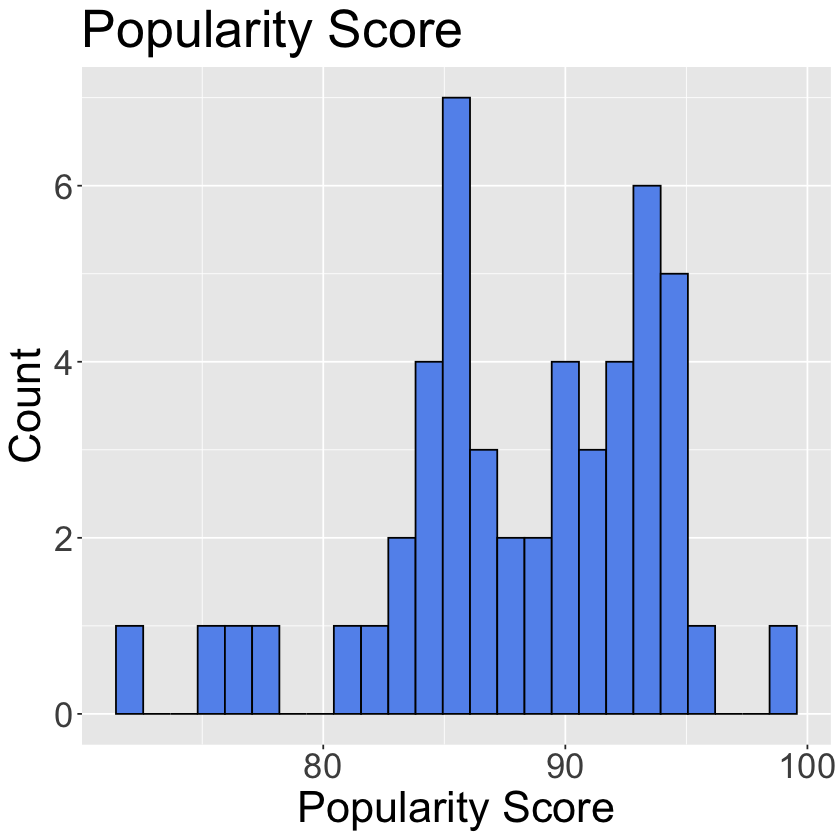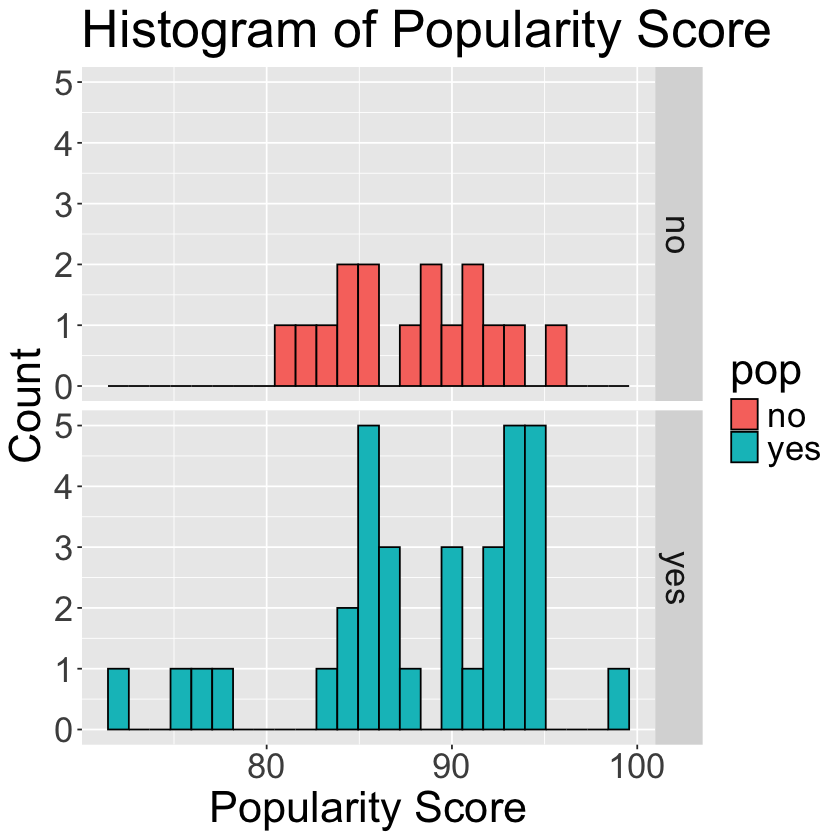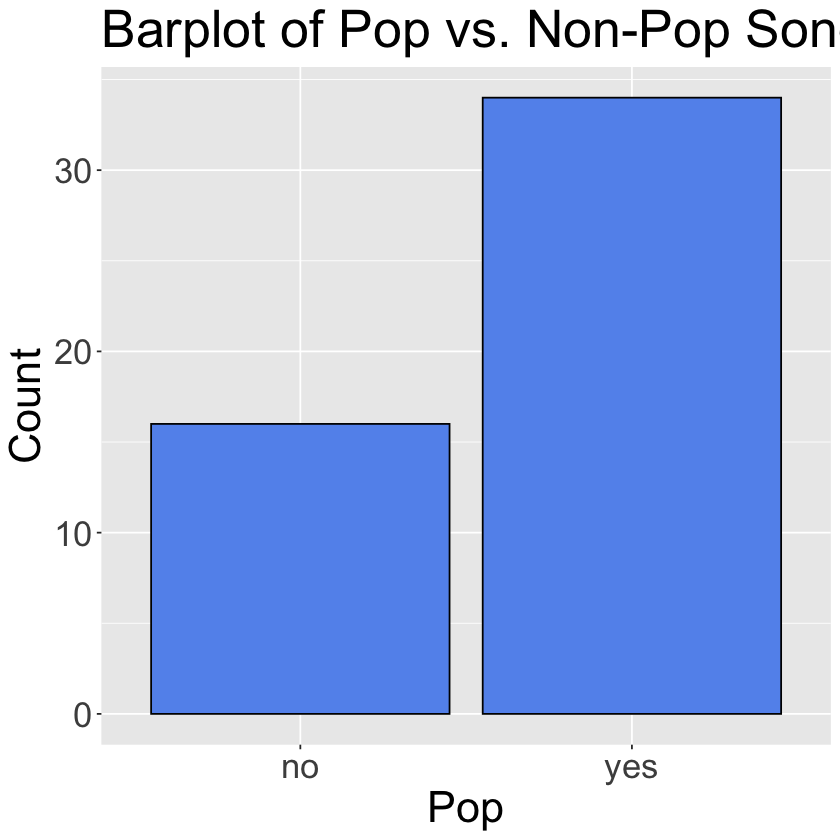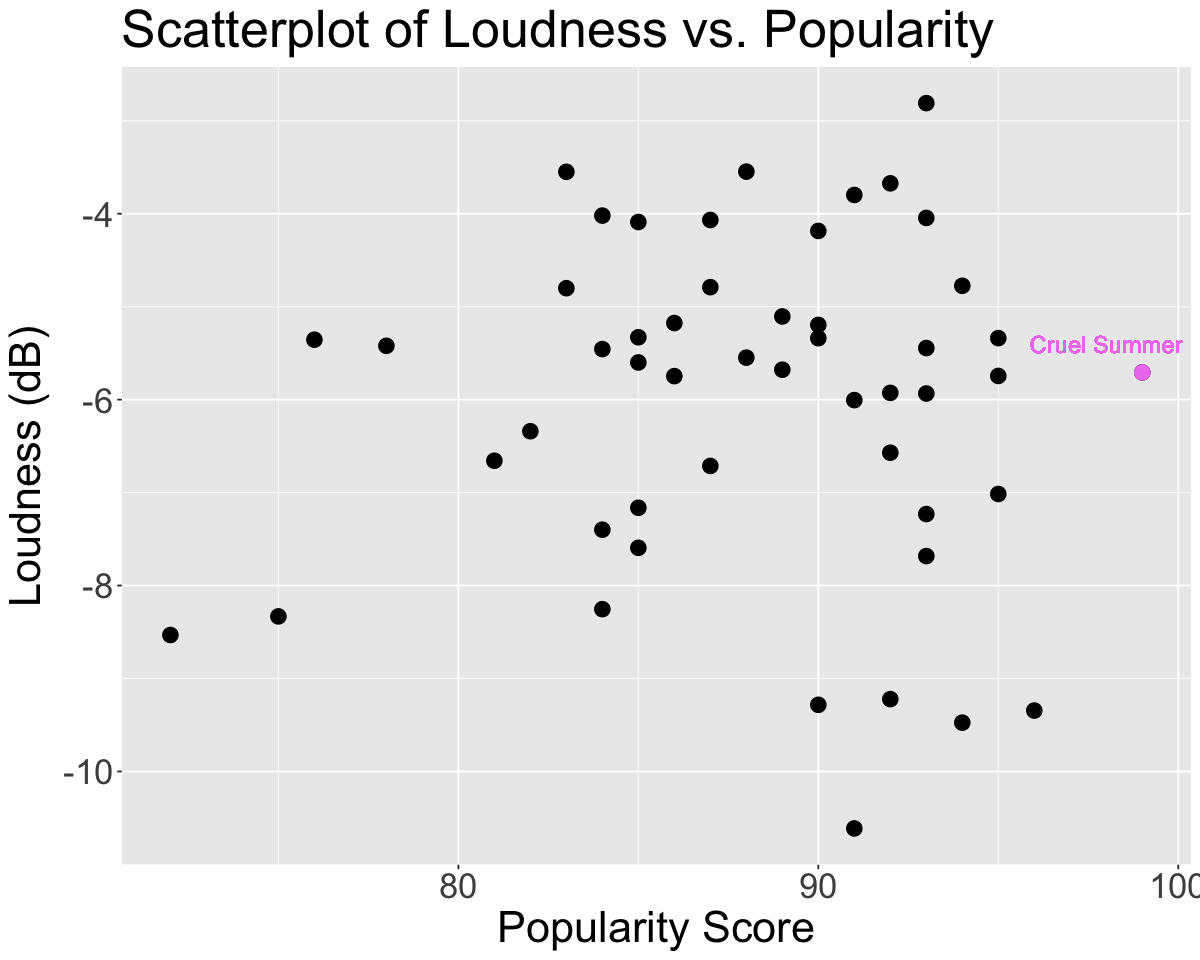Worksheet 1#
Girls in Data Science Camp#
In this worksheet, we will be using a data set obtained from the Spotify Web API the top 50 tracks from 2023 (more details can be found here).

I have reduced the data set to include the following variables:
artist_name: the artist name
track_name: the title of the track
album_release_date: The date when the track was released
genres: A list of genres associated with the track’s artist(s)
danceability: A measure from 0.0 to 1.0 indicating how suitable a track is for dancing based on a combination of musical elements
energy: A measure from 0.0 to 1.0 representing a perceptual measure of intensity and activity
loudness: The overall loudness of a track in decibels (dB)
key: The key the track is in. Integers map to pitches using standard Pitch Class notation.
tempo: The overall estimated tempo of a track in beats per minute (BPM)
duration_ms: The length of the track in milliseconds
time_signature: An estimated overall time signature of a track
popularity: A score between 0 and 100, with 100 being the most popular
I also included a new variable called pop which is yes if the song falls into any type of pop genre and no otherwise.
# Load libraries
library(tidyverse)
── Attaching core tidyverse packages ───────────────────────────────────────────────────────────────── tidyverse 2.0.0 ──
✔ dplyr 1.1.4 ✔ readr 2.1.5
✔ forcats 1.0.0 ✔ stringr 1.5.1
✔ ggplot2 3.5.1 ✔ tibble 3.2.1
✔ lubridate 1.9.3 ✔ tidyr 1.3.1
✔ purrr 1.0.2
── Conflicts ─────────────────────────────────────────────────────────────────────────────────── tidyverse_conflicts() ──
✖ dplyr::filter() masks stats::filter()
✖ dplyr::lag() masks stats::lag()
ℹ Use the conflicted package (<http://conflicted.r-lib.org/>) to force all conflicts to become errors
# Read in the data
spotify <- read_csv("data/spotify_top_50_2023.csv")
Rows: 50 Columns: 12
── Column specification ─────────────────────────────────────────────────────────────────────────────────────────────────
Delimiter: ","
chr (3): artist_name, track_name, genres
dbl (8): danceability, energy, loudness, key, tempo, duration_ms, time_sign...
date (1): album_release_date
ℹ Use `spec()` to retrieve the full column specification for this data.
ℹ Specify the column types or set `show_col_types = FALSE` to quiet this message.
# Create 'pop' column
spotify <- spotify |>
mutate(pop = if_else(str_detect(genres, "pop"), "yes", "no"))
head(spotify)
| artist_name | track_name | album_release_date | genres | danceability | energy | loudness | key | tempo | duration_ms | time_signature | popularity | pop |
|---|---|---|---|---|---|---|---|---|---|---|---|---|
| <chr> | <chr> | <date> | <chr> | <dbl> | <dbl> | <dbl> | <dbl> | <dbl> | <dbl> | <dbl> | <dbl> | <chr> |
| Miley Cyrus | Flowers | 2023-08-18 | ['pop'] | 0.706 | 0.691 | -4.775 | 0 | 118.048 | 200600 | 4 | 94 | yes |
| SZA | Kill Bill | 2022-12-08 | ['pop', 'r&b', 'rap'] | 0.644 | 0.735 | -5.747 | 8 | 88.980 | 153947 | 4 | 86 | yes |
| Harry Styles | As It Was | 2022-05-20 | ['pop'] | 0.520 | 0.731 | -5.338 | 6 | 173.930 | 167303 | 4 | 95 | yes |
| Jung Kook | Seven (feat. Latto) (Explicit Ver.) | 2023-11-03 | ['k-pop'] | 0.790 | 0.831 | -4.185 | 11 | 124.987 | 183551 | 4 | 90 | yes |
| Eslabon Armado | Ella Baila Sola | 2023-04-28 | ['corrido', 'corridos tumbados', 'sad sierreno', 'sierreno'] | 0.668 | 0.758 | -5.176 | 5 | 147.989 | 165671 | 3 | 86 | no |
| Taylor Swift | Cruel Summer | 2019-08-23 | ['pop'] | 0.552 | 0.702 | -5.707 | 9 | 169.994 | 178427 | 4 | 99 | yes |
Exercise 1: Wrangling#
1.1#
Is the spotify data tidy? Why or why not?
Answer: The data set is mostly tidy: each row corresponds to a single observation and each column corresponds to a single variable. However, each cell does not always correspond to a single value. For example, the genres column sometimes displays multiple genres per song (e.g., the song “Kill Bill” is clsasified as three genres: pop, r&b and rap).
1.2#
What are the dimensions of this data set (i.e., the number of rows and columns)?
dim(spotify)
- 50
- 13
1.3#
Without examining the entire data set, which artist and track is in the 35th row of the data set? Note that your code should return only the required variables (artist_name and track_name).
spotify |>
slice(35) |>
select(artist_name, track_name)
| artist_name | track_name |
|---|---|
| <chr> | <chr> |
| Doja Cat | Paint The Town Red |
1.4#
Create a subset of the data that only includes tracks with a popularity score over 90. Assign this to an object called pop_90. How many songs have a popularity score over 90?
pop_90 <- spotify |>
filter(popularity > 90)
pop_90
| artist_name | track_name | album_release_date | genres | danceability | energy | loudness | key | tempo | duration_ms | time_signature | popularity | pop |
|---|---|---|---|---|---|---|---|---|---|---|---|---|
| <chr> | <chr> | <date> | <chr> | <dbl> | <dbl> | <dbl> | <dbl> | <dbl> | <dbl> | <dbl> | <dbl> | <chr> |
| Miley Cyrus | Flowers | 2023-08-18 | ['pop'] | 0.706 | 0.691 | -4.775 | 0 | 118.048 | 200600 | 4 | 94 | yes |
| Harry Styles | As It Was | 2022-05-20 | ['pop'] | 0.520 | 0.731 | -5.338 | 6 | 173.930 | 167303 | 4 | 95 | yes |
| Taylor Swift | Cruel Summer | 2019-08-23 | ['pop'] | 0.552 | 0.702 | -5.707 | 9 | 169.994 | 178427 | 4 | 99 | yes |
| Metro Boomin | Creepin' (with The Weeknd & 21 Savage) | 2022-12-02 | ['rap'] | 0.715 | 0.620 | -6.005 | 1 | 97.950 | 221520 | 4 | 91 | no |
| Taylor Swift | Anti-Hero | 2022-10-21 | ['pop'] | 0.637 | 0.643 | -6.571 | 4 | 97.008 | 200690 | 4 | 92 | yes |
| Arctic Monkeys | I Wanna Be Yours | 2013-09-09 | ['garage rock', 'modern rock', 'permanent wave', 'rock', 'sheffield indie'] | 0.464 | 0.417 | -9.345 | 0 | 67.528 | 183956 | 4 | 96 | no |
| David Guetta | I'm Good (Blue) | 2022-08-26 | ['big room', 'dance pop', 'edm', 'pop', 'pop dance'] | 0.561 | 0.965 | -3.673 | 7 | 128.040 | 175238 | 4 | 92 | yes |
| David Kushner | Daylight | 2023-04-14 | ['gen z singer-songwriter', 'singer-songwriter pop'] | 0.508 | 0.430 | -9.475 | 2 | 130.090 | 212954 | 4 | 94 | yes |
| The Weeknd | Starboy | 2016-11-25 | ['canadian contemporary r&b', 'canadian pop', 'pop'] | 0.679 | 0.587 | -7.015 | 7 | 186.003 | 230453 | 4 | 95 | yes |
| OneRepublic | I Ain't Worried | 2022-05-13 | ['piano rock', 'pop'] | 0.704 | 0.797 | -5.927 | 0 | 139.994 | 148486 | 4 | 92 | yes |
| Myke Towers | LALA | 2023-03-23 | ['reggaeton', 'trap latino', 'urbano latino'] | 0.708 | 0.737 | -4.045 | 1 | 91.986 | 197920 | 4 | 93 | no |
| Doja Cat | Paint The Town Red | 2023-09-20 | ['dance pop', 'pop'] | 0.864 | 0.556 | -7.683 | 2 | 99.974 | 230480 | 4 | 93 | yes |
| The Neighbourhood | Sweater Weather | 2013-04-19 | ['modern alternative rock', 'modern rock', 'pop'] | 0.612 | 0.807 | -2.810 | 10 | 124.053 | 240400 | 4 | 93 | yes |
| SZA | Snooze | 2022-12-09 | ['pop', 'r&b', 'rap'] | 0.559 | 0.551 | -7.231 | 5 | 143.008 | 201800 | 4 | 93 | yes |
| The Weeknd | Blinding Lights | 2020-03-20 | ['canadian contemporary r&b', 'canadian pop', 'pop'] | 0.514 | 0.730 | -5.934 | 1 | 171.005 | 200040 | 4 | 93 | yes |
| Jimin | Like Crazy | 2023-03-24 | ['k-pop'] | 0.629 | 0.733 | -5.445 | 7 | 120.001 | 212241 | 4 | 93 | yes |
| Eminem | Mockingbird | 2004-11-12 | ['detroit hip hop', 'hip hop', 'rap'] | 0.637 | 0.678 | -3.798 | 0 | 84.039 | 250760 | 4 | 91 | no |
| Olivia Rodrigo | vampire | 2023-09-08 | ['pop'] | 0.511 | 0.532 | -5.745 | 5 | 138.005 | 219724 | 4 | 95 | yes |
| Tyler, The Creator | See You Again (feat. Kali Uchis) | 2017-07-21 | ['hip hop', 'rap'] | 0.558 | 0.559 | -9.222 | 6 | 78.558 | 180387 | 4 | 92 | no |
| d4vd | Romantic Homicide | 2022-07-20 | ['bedroom pop'] | 0.571 | 0.544 | -10.613 | 6 | 132.052 | 132631 | 4 | 91 | yes |
nrow(pop_90)
20 tracks have a popularity score over 90.
1.5#
Now, I want to look at pop songs that have a danceability score over 0.7. Create a subset of the spotify data set to achieve this task, ordered from highest to lowest danceability.
spotify |>
filter(danceability > 0.7 & pop == "yes") |>
arrange(by = desc(danceability))
| artist_name | track_name | album_release_date | genres | danceability | energy | loudness | key | tempo | duration_ms | time_signature | popularity | pop |
|---|---|---|---|---|---|---|---|---|---|---|---|---|
| <chr> | <chr> | <date> | <chr> | <dbl> | <dbl> | <dbl> | <dbl> | <dbl> | <dbl> | <dbl> | <dbl> | <chr> |
| Ozuna | Hey Mor | 2022-10-07 | ['puerto rican pop', 'reggaeton', 'trap latino', 'urbano latino'] | 0.901 | 0.589 | -6.713 | 1 | 98.002 | 196600 | 4 | 87 | yes |
| Doja Cat | Paint The Town Red | 2023-09-20 | ['dance pop', 'pop'] | 0.864 | 0.556 | -7.683 | 2 | 99.974 | 230480 | 4 | 93 | yes |
| Feid | CLASSY 101 | 2023-03-31 | ['colombian pop', 'pop reggaeton', 'reggaeton', 'reggaeton colombiano', 'trap latino', 'urbano latino'] | 0.859 | 0.658 | -4.790 | 11 | 100.065 | 195987 | 4 | 87 | yes |
| Manuel Turizo | La Bachata | 2023-03-17 | ['colombian pop', 'latin pop', 'reggaeton', 'reggaeton colombiano', 'trap latino', 'urbano latino'] | 0.835 | 0.679 | -5.329 | 7 | 124.980 | 162638 | 4 | 85 | yes |
| NewJeans | OMG | 2023-01-02 | ['k-pop', 'k-pop girl group'] | 0.804 | 0.771 | -4.067 | 9 | 126.956 | 212253 | 4 | 87 | yes |
| Rema | Calm Down (with Selena Gomez) | 2023-04-27 | ['afrobeats', 'nigerian pop'] | 0.799 | 0.802 | -5.196 | 11 | 107.008 | 239318 | 4 | 90 | yes |
| Jung Kook | Seven (feat. Latto) (Explicit Ver.) | 2023-11-03 | ['k-pop'] | 0.790 | 0.831 | -4.185 | 11 | 124.987 | 183551 | 4 | 90 | yes |
| FIFTY FIFTY | Cupid - Twin Ver. | 2023-09-22 | ['k-pop girl group'] | 0.783 | 0.592 | -8.332 | 11 | 120.018 | 174253 | 4 | 75 | yes |
| Bizarrap | Shakira: Bzrp Music Sessions, Vol. 53 | 2023-01-11 | ['argentine hip hop', 'pop venezolano', 'trap argentino', 'trap latino', 'urbano latino'] | 0.778 | 0.632 | -5.600 | 2 | 122.104 | 218289 | 4 | 85 | yes |
| Taylor Swift | Blank Space | 2014-10-27 | ['pop'] | 0.753 | 0.678 | -5.421 | 5 | 96.006 | 231827 | 4 | 78 | yes |
| Sam Smith | Unholy (feat. Kim Petras) | 2023-01-27 | ['pop', 'uk pop'] | 0.712 | 0.463 | -7.399 | 2 | 131.199 | 156943 | 4 | 84 | yes |
| Miley Cyrus | Flowers | 2023-08-18 | ['pop'] | 0.706 | 0.691 | -4.775 | 0 | 118.048 | 200600 | 4 | 94 | yes |
| OneRepublic | I Ain't Worried | 2022-05-13 | ['piano rock', 'pop'] | 0.704 | 0.797 | -5.927 | 0 | 139.994 | 148486 | 4 | 92 | yes |
1.6#
What is the average danceability score for Taylor Swift songs?
# Filter for only Taylor Swift songs
spotify |>
filter(artist_name == "Taylor Swift")
| artist_name | track_name | album_release_date | genres | danceability | energy | loudness | key | tempo | duration_ms | time_signature | popularity | pop |
|---|---|---|---|---|---|---|---|---|---|---|---|---|
| <chr> | <chr> | <date> | <chr> | <dbl> | <dbl> | <dbl> | <dbl> | <dbl> | <dbl> | <dbl> | <dbl> | <chr> |
| Taylor Swift | Cruel Summer | 2019-08-23 | ['pop'] | 0.552 | 0.702 | -5.707 | 9 | 169.994 | 178427 | 4 | 99 | yes |
| Taylor Swift | Anti-Hero | 2022-10-21 | ['pop'] | 0.637 | 0.643 | -6.571 | 4 | 97.008 | 200690 | 4 | 92 | yes |
| Taylor Swift | Blank Space | 2014-10-27 | ['pop'] | 0.753 | 0.678 | -5.421 | 5 | 96.006 | 231827 | 4 | 78 | yes |
# Compute the average danceability score using `summarize`
spotify |>
filter(artist_name == "Taylor Swift") |>
summarize(avg_dance_TS = mean(danceability))
| avg_dance_TS |
|---|
| <dbl> |
| 0.6473333 |
1.7#
Are Taylor Swfit’s songs more danceable than The Weekend’s? Hint: use group_by.
spotify |>
group_by(artist_name) |>
summarize(avg_dance = mean(danceability)) |>
filter(artist_name == "Taylor Swift" | artist_name == "The Weeknd")
| artist_name | avg_dance |
|---|---|
| <chr> | <dbl> |
| Taylor Swift | 0.6473333 |
| The Weeknd | 0.5885000 |
1.8#
Are pop songs more popular than other genres? Compare the average popularity scores between pop songs vs. other genres.
spotify |>
group_by(pop) |>
summarize(avg_popularity = mean(popularity))
| pop | avg_popularity |
|---|---|
| <chr> | <dbl> |
| no | 87.75000 |
| yes | 88.26471 |
Exercise 2: Data Visualization#
2.1#
Using a histogram, visualize the distribution of popularity scores for Spotify’s top 50 tracks from 2023. Describe what you see.
ggplot(spotify, aes(x = popularity)) +
geom_histogram(bins=25, fill = "cornflowerblue", color = "black") +
theme(text = element_text(size = 26)) + # increase text size
labs(x='Popularity Score', y='Count', title='Popularity Score')
The popularity scores are distributed from about 72-99, with two main points of concentration around approximately 85 and 95.
2.2#
Are pop songs more popular than other genres? You answered this in question 1.8 using summary statistics, but now use histograms to visualize the popularity groups for the two groups on the same graph. Do you notice anything different?
Hint: use
facet_grid
ggplot(spotify, aes(x = popularity, fill = pop)) +
geom_histogram(bins=25, color = "black") +
facet_grid(rows = vars(pop)) +
theme(text = element_text(size = 26)) +
labs(x='Popularity Score', y='Count', title='Histogram of Popularity Score ')
While the center of the two distributions are very similar (both around 88), we can see that the distribution of popularity scores for pop songs has more variability and a wider spread than songs that are not classified as pop.
2.3#
Create a barplot comparing the counts of pop songs vs. non-pop songs.
2.4#
Is there a relationship between how loud a song is in decibels and its popularity? Visualize the relationship between loudness and popularity with a scatterplot, plotting loudness on the \(y\)-axis and popularity on the \(x\)-axis. What do you notice?
options(repr.plot.width = 10, repr.plot.height = 8)
ggplot(spotify, aes(x = popularity, y = loudness)) +
geom_point(size=4) +
theme(text = element_text(size = 26)) +
labs(x='Popularity Score', y='Loudness (dB)',title='Scatterplot of Loudness vs. Popularity') # rename axes and add title
It seems like there is a relatively weak positive relationship between loudness and popularity score.
2.5 (Challenge)#
Find the song that has the highest popularity score, but a relatively moderate loudness. Highlight the point on the graph and label it.
Hint: Use the
annotatefunction to highlight a point
spotify |>
arrange(desc(popularity)) |>
slice(1) |>
select(artist_name, track_name, popularity, loudness)
| artist_name | track_name | popularity | loudness |
|---|---|---|---|
| <chr> | <chr> | <dbl> | <dbl> |
| Taylor Swift | Cruel Summer | 99 | -5.707 |
options(repr.plot.width = 10, repr.plot.height = 8)
ggplot(spotify, aes(x = popularity, y = loudness)) +
geom_point(size=4) +
annotate("point", x = 99, y = -5.707, color = 'violet', size = 4) +
geom_text(x = 98, y = -5.4 , label = "Cruel Summer", color = "violet", size = 5) + # add text to plot
theme(text = element_text(size = 26)) +
labs(x='Popularity Score', y='Loudness (dB)',title='Scatterplot of Loudness vs. Popularity') # rename axes and add title
2.6 (Challenge)#
List the artists who have more than one track in the top 50. For each artist, show the number of tracks and their average popularity score.
popular_artists <- spotify |>
group_by(artist_name) |>
summarize(track_count = n(), avg_popularity = mean(popularity)) |>
filter(track_count > 1)
popular_artists
| artist_name | track_count | avg_popularity |
|---|---|---|
| <chr> | <int> | <dbl> |
| Bad Bunny | 2 | 86.50000 |
| Bizarrap | 2 | 86.50000 |
| SZA | 2 | 89.50000 |
| Taylor Swift | 3 | 89.66667 |
| The Weeknd | 4 | 89.50000 |
| d4vd | 2 | 90.50000 |





